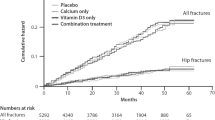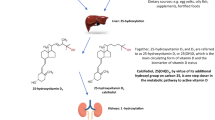Abstract.
Normal intestinal calcium (Ca) absorption is an essential feature of bone homeostasis. As with many other organ systems, intestinal Ca absorption declines with aging, and this is one pathological factor that has been identified as a cause of senile osteoporosis in the elderly. This abnormality leads to secondary hyperparathyroidism, which is characterized by high serum parathyroid hormone (PTH) and an increase in bone resorption. Secondary hyperparathyroidism due to poor intestinal Ca absorption has been implicated not only in senile osteoporosis but also in age-related bone loss. Accordingly, in population-based studies, there is a gradual increase in serum PTH from about 20 years of age onward, which constitutes a maximum increase at 80 years of age of 50% of the basal value seen at 30 years of age. The cause of the increase in PTH is thought to be partly due to impaired intestinal Ca absorption that is associated with aging, a cause that is not entirely clear but at least in some instances is related to some form of vitamin D deficiency. There are three types of vitamin D deficiency: (1) primary vitamin D deficiency, which is due to a deficiency of vitamin D, the parent compound; (2) a deficiency of 1,25(OH)2D3 resulting from decreased renal production of 1,25(OH)2D3; and (3) resistance to 1,25(OH)2D3 action owing to decreased responsiveness to 1,25(OH)2D3 of target tissues. The cause for the resistance to 1,25(OH)2D3 could be related to the finding that the vitamin D receptor level in the intestine tends to decrease with age. All three types of deficiencies can occur with aging, and each has been implicated as a potential cause of intestinal Ca malabsorption, secondary hyperparathyroidism, and senile osteoporosis. There are two forms of vitamin D replacement therapies: plain vitamin D therapy and active vitamin D analog (or D-hormone) therapy. Primary vitamin D deficiency can be corrected by vitamin supplements of 1000 U a day of plain vitamin D whereas 1,25(OH)2D3 deficiency/resistance requires active vitamin D analog therapy [1,25(OH)2D3 or 1α(OH)D3] to correct the high serum PTH and the Ca malabsorption. In addition, in the elderly, there are patients with decreased intestinal Ca absorption but with apparently normal vitamin D metabolism. Although the cause of poor intestinal Ca absorption in these patients is unclear, these patients, as well as all other patients with secondary hyperparathyroidism (not due to decreased renal function), show a decrease in serum PTH and an increase in Ca absorption in response to therapy with 1,25(OH)2D3 or 1α(OH)D3. In short, it is clear that some form of vitamin D therapy, either plain vitamin D or 1,25(OH)2D3 or 1α(OH)D3, can be used to correct all types of age-dependent impairments in intestinal Ca absorption and secondary hyperparathyroidism during aging. However, from a clinical standpoint, it is important to recognize the type of vitamin D deficiency in patients with senile osteoporosis so that primary vitamin D deficiency can be appropriately treated with plain vitamin D therapy, whereas 1,25(OH)2D3 deficiency/resistance will be properly treated with 1,25(OH)2D3 or 1α(OH)D3 therapy. With respect to postmenopausal osteoporosis, there is strong evidence that active vitamin D analogs (but not plain vitamin D) may have bone-sparing actions. However, these effects appear to be results of their pharmacologic actions on bone formation and resorption rather than through replenishing a deficiency.
Similar content being viewed by others
Author information
Authors and Affiliations
Rights and permissions
About this article
Cite this article
Lau, KH., Baylink, D. Vitamin D Therapy of Osteoporosis: Plain Vitamin D Therapy Versus Active Vitamin D Analog (D-Hormone) Therapy. Calcif Tissue Int 65, 295–306 (1999). https://doi.org/10.1007/s002239900702
Published:
Issue Date:
DOI: https://doi.org/10.1007/s002239900702




